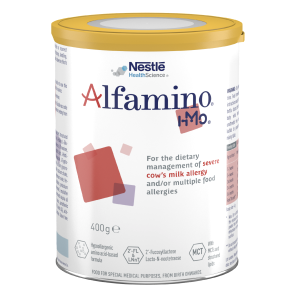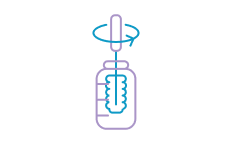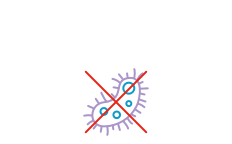ALFAMINO® Junior HMO:
ADVANCING THE MANAGEMENT OF SEVERE COW’S MILK PROTEIN ALLERGY
- Amino acid-based, hypoallergenic formula (AAF) designed to support children over 1 year of age with severe cow’s milk protein allergy (CMPA) and/or multiple food allergies and/or malabsorptive conditions1-6
- Contains 2’FL and LNnT†, to nurture infants’ developing immune systems7-12
- Designed to support gastrointestinal tolerance and facilitate absorption in the most challenging conditions13-19
- Nutritionally complete and tailored to the growing needs of children with CMPA and/or food allergies aged one year and above to support normal growth and development.20 Suitable as a sole source of nutrition or as part of a complementary diet from 1 year of age.
DOWNLOAD BROCHURE
HYPOALLERGENIC AND NUTRITIONALLY
TAILORED TO SUPPORT NORMAL GROWTH
Children with CMPA and/or multiple food allergies over 1 year of age are at a higher risk of nutritional deficiencies21 (e.g. calcium, iron, vitamin D, vitamin B12 and Iodine) as well as impaired growth.22 Without professional dietetic support and advice, children with food allergies, including CMPA, have been shown to have significantly lower growth parameters than those without.22-23
Alfamino® Junior HMO is a hypoallergenic amino acid-based formula that is nutritionally tailored for the healthy growth and development of children over 1 year of age, supporting the intake of key nutrients at risk in CMPA:1-2620
| Daily recommended intake at 1-3 yrs of age by EFSA20 | Met by Alfamino® Junior HMO (300ml/day)6 | |
| Calcium (mg) | 450 | 67% |
| Iron (mg) | 7 | 69% |
| Vitamin D (µg) | 15 | 38% |
| Vitamin B12 (µg) | 1.5 | 60% |
| Iodine (µg) | 90 | 37% |
MEET DIEGO
Feeding:
Formula-fed with Alfamino ® HMO and complementary feeding
Diagnosis:
Persistent allergies to cow`s milk protein and soy
Age:
15 months old
Fictional patient profile for illustrative purpose only
WHAT WOULD YOU RECOMMEND FOR DIEGO?
- AMINO ACID-BASED FORMULA
- FORTIFIED PLANT-BASED MILK SUBSTITUTE
The World Health Organization recommends exclusive breastfeeding up to 6 months along with appropriate complementary feeding up to 2 years of age or longer. As such, for infants on an amino acid-based formula, with persistent CMPA and/or multiple food allergies beyond one year of age, continued use of an age-adapted amino acid-based formula, such as Alfamino® Junior HMO, should also be considered to help meet their nutritional needs. 3 ,34 35
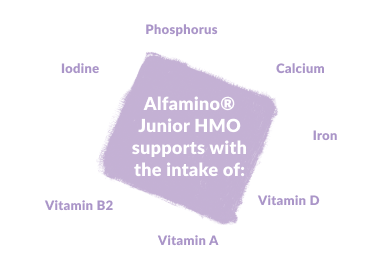
Alfamino® Junior HMO is suitable as a sole source of nutrition or as part of a complementary feeding diet from 1 year
of age.
Alfamino
®
Junior HMO is nutritionally tailored for children with CMPA and/or food allergies aged one year and above.
It supports the intake of key vitamins and minerals at risk in CMPA, such as Calcium, Iron, vitamin D, vitamin B12 and
Iodine, and is suitable as a sole source of nutrition or as part of
a complementary feeding diet.
After infancy, It is becoming increasingly popular to replace speciality formulas, such as amino acid-based formulas, with
fortified plant-based milks for the management of CMPA. However, this practice is not supported by most scientific societies
as their protein, vitamin and mineral levels are generally not tailored for early childhood and/or those on an elimination diet.
Furthermore, they do not offer any immune-nurturing properties to support a developing immune system.
The development of the immune system of those with CMPA is affected by gut microbiota dysbiosis and increased gut
permeability.
24-26,33,36
Alfamino
®
Junior HMO contains 2’FL and LNnT
†
which have been shown to reduce the risk of infections and associated
medication use:
9-11
|
HEALTHY INFANTS
11
Mean trial duration: 12 months |
INFANTS WITH CMPA
9-10
Mean trial duration: 8.8 months |
|
| Ear infections | -46% ‡ | -71% ‡ |
| Lower respiratory tract infections | 55% * | -34% ‡ |
| Bronchitis | -70% ** | |
| Gastrointestinal infections | -40% ‡ | |
| Frequency of upper respiratory tract infections | -42% * | |
| Antibiotic use | -53% * | 6% ‡ |
| Antipyretic use | -56% *** | 11% ‡ |
* p ≤ 0.05; ** p ≤ 0.01; *** p ≤ 0.05 at 4 months only; ‡ p = N.S.
FREQUENTLY ASKED QUESTIONS
HCP HMO Page FAQs
Our range of immune-nurturing formulas for cow’s milk protein allergy
The Nestlé Health Science range of nutritional solutions is tailor-made for infants and young children with cow’s milk protein allergy and other food allergies/intolerances. This complete range has been specifically designed to help manage cow’s milk protein allergy earlier, with the right product from the beginning.
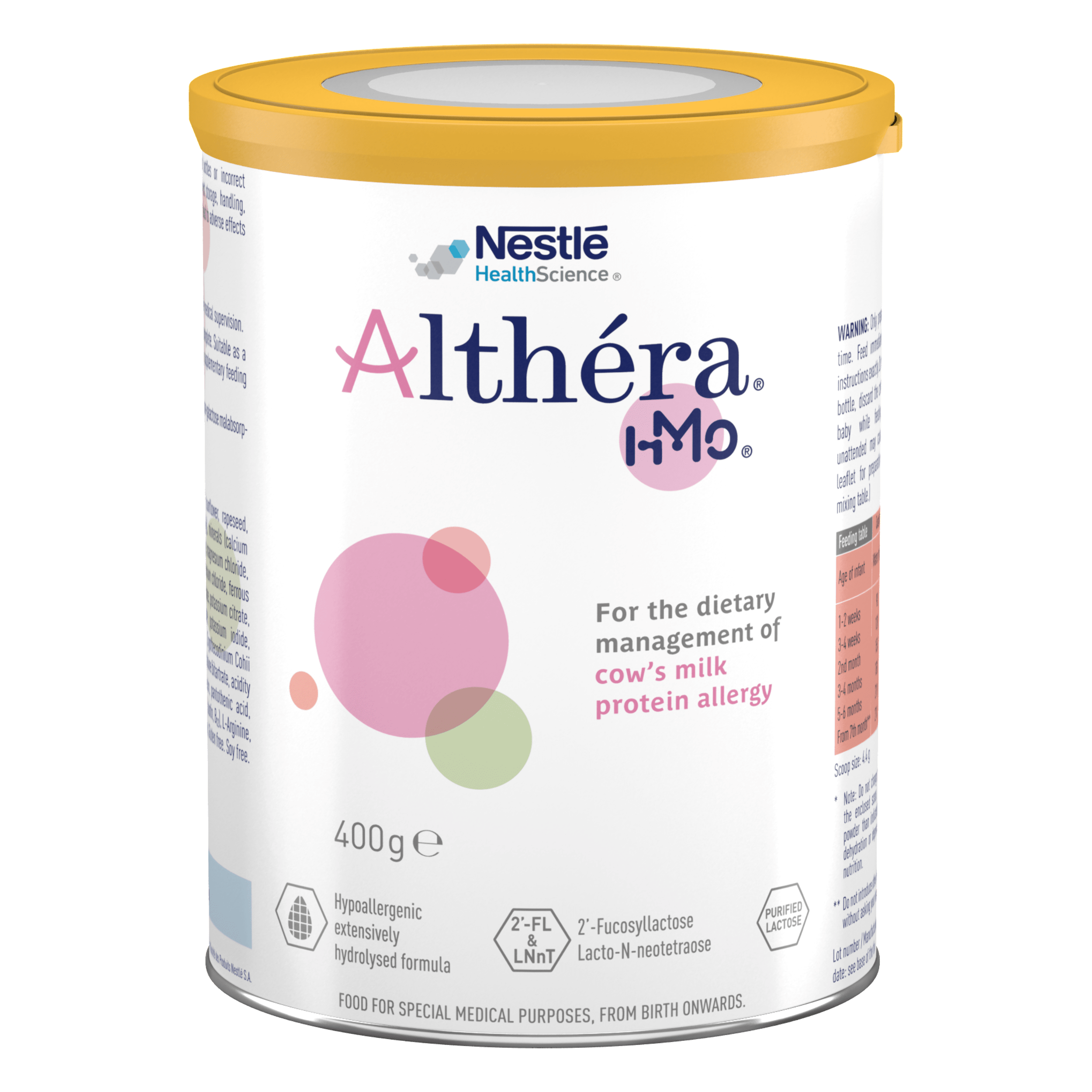
Althéra® HMO
Althéra® HMO is the first choice for infants and young children with CMPA.
View product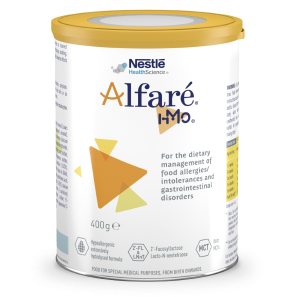
Alfaré® HMO
Alfaré® HMO is the first choice for GI impaired infants and young children with CMPA and/or food intolerance.
View product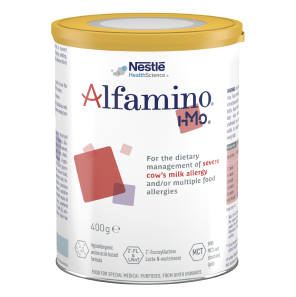
Alfamino® HMO
Alfamino® HMO is the first choice for infants and young children with severe CMPA and/or multiple food allergies.
View product* Structurally identical Human Milk Oligosaccharides are not sourced from human milk.
REFERENCES:
-
Nowak-Węgrzyn A, et al. Evaluation of Hypoallergenicity of a New, Amino Acid–Based Formula. Clin Pediatr (Phila) 2015;54:264–272.
-
Nowak-Wegrzyn A, et al. Confirmed Hypoallergenicity of a Novel Whey-Based Extensively Hydrolyzed Infant Formula Containing Two Human Milk Oligosaccharides. Nutrients 2019;11(7):E1447.
-
Cekola P, et al. Clinical use and safety of an amino acid-based infant formula in a real world setting. Abstract presented at NASPGHAN. Chicago, IL, USA, October 2019.
-
Koletzko S, et al. Diagnostic Approach and Management of Cow’s-Milk Protein Allergy in Infants and Children: ESPGHAN GI Committee Practical Guidelines. J Pediatr Gastroenterol Nutr 2012;55(2):221-229.
-
Luyt D, et al. BSACI guideline for the diagnosis and management of cow’s milk allergy. Clin Exp Allergy 2014;44(5):642-672.
-
Muraro A, et al. EAACI Food Allergy and Anaphylaxis Guidelines: diagnosis and management of food allergy. Allergy 2014;69(8):1008–1025.
-
Bode L. Human milk oligosaccharides: Every baby needs a sugar mama. Glycobiology 2012;22(9):1147-1162.
-
Donovan SM and Comstock SS. Human Milk Oligosaccharides Influence Neonatal Mucosal and Systemic Immunity. Ann Nutr Metab 2016;69(suppl 2):42-51.
-
Nestlé Health Science, data on file. CINNAMON study.
-
Vandenplas Y, et al. Growth, tolerance and safety of an extensively hydrolysed formula containing two human milk oligosaccharides in infants with cow’s milk protein allergy. Abstract presented at PAAM. Florence, Italy, October 19, 2019.
-
Puccio G, et al. Effects of Infant Formula With Human Milk Oligosaccharides on Growth and Morbidity: A Randomized Multicenter Trial. J Pediatr Gastroenterol Nutr 2017;64(4):624-631.
-
Heine RG, et al. Lactose intolerance and gastrointestinal cow’s milk allergy in infants and children – common misconceptions revisited. World Allergy Organ J 2017;10(1):41.
-
Delplanque B, et al. Lipid Quality in Infant Nutrition: Current Knowledge and Future Opportunities. J Pediatr Gastroenterol Nutr 2015;61(1):8-17.
-
Bach AC, et al. Medium-chain triglycerides : an update. Am J Clin Nutr 1982;36(5):950-962.
-
Kennedy K, et al. Double-blind, randomized trial of a synthetic triacylglycerol in formula-fed term infants: effects on stool biochemistry, stool characteristics, and bone mineralization. Am J Clin Nutr 1999;70(5):920-927.
-
Koletzko B. Human milk lipids. Ann Nutr Metab 2016;69(suppl 2):28-40.
-
Mazzocchi A, et al. The Role of Lipids in Human Milk and Infant Formulae. Nutrients 2018;10(5):E567.
-
American Academy of Pediatrics, Committee on Nutrition. Pediatrics 1976;57:278-285.
-
Nestlé Health Science, data on file. Alfamino® product composition.
-
Corkins M, et al. Assessment of Growth of Infants Fed an Amino Acid-Based Formula. Clin Med Insights Pediatr 2016;10:3–9.
-
Vandenplas Y, et al. Growth in infants with cow’s milk protein allergy fed an amino acid-based formula. Abstract N-O-013 presented at ESPGHAN, 2019. J Pediatr Gastroenterol Nutr 2019;68(Suppl 1).
-
Nestlé Health Science, data on file. Alfamino® versus Neocate® competitive benchmarking test.
-
Host A and Halken S. Cow's milk allergy: where have we come from and where are we going? Endocr Metab Immune Disord Drug Targets 2014;14(1):2-8.
-
Azad MB, et al. Infant gut microbiota and food sensitization: associations in the first year of life. Clin Exp Allergy 2015;45(3):632-643.
-
West CE, et al. The gut microbiota and its role in the development of allergic disease: a wider perspective Clin Exp Allergy 2015;45(1):43–53.
-
Thompson-Chagoyan OC, et al. Faecal Microbiota and Short-Chain Fatty Acid Levels in Faeces from Infants with Cow‘s Milk Protein Allergy Int Arch Allergy Immunol 2011;156(3):325–332.
-
Chin AM, et al. Morphogenesis and maturation of the embryonic and postnatal intestine. Semin Cell Dev Biol 2017;66:81-93.
-
Tanaka M and Nakayama J. Development of the gut microbiota in infancy and its impact on health in later life Allergol Int 2017;66(4):515-522.
-
Newburg DS and Walker WA. Protection of the Neonate by the Innate Immune System of Developing Gut and of Human Milk. Pediatr Res 2007;61(1):2-8.
-
Woicka-Kolejwa K, et al. Food allergy is associated with recurrent respiratory tract infections during childhood. Postepy Dermatol Alergol 2016;33(2):109-113.
-
Juntti H, et al. Cow’s Milk Allergy is Associated with Recurrent Otitis Media During Childhood. Acta Otolaryngol 1999;119(8):867-873.
-
Tikkanen S, et al. Status of children with cow’s milk allergy in infancy by 10 years of Age. Acta Paediatr 2000; 89(10):1174-1180.
-
Jalonen T. Identical intestinal permeability changes in children with different clinical manifestations of cow’s milk allergy. J allergy Clin Immunol 1991;88(5):737-742.
-
Crittenden RG and Bennett LE. Cow’s Milk Allergy: A Complex Disorder. J Am Coll Nutr 2005;24(6suppl):582S–591S.
IMPORTANT NOTICE:
Mothers should be encouraged to continue breastfeeding even when their infants have cow’s milk protein allergy. This usually requires qualified dietary counseling to completely exclude all sources of cow’s milk protein from the mothers’ diet. If a decision to use a special formula intended for infants is taken, it is important to give instructions on correct preparation methods, emphasizing that unboiled water, unsterilized bottles or incorrect dilution can all lead to illness. Formula for special medical purposes intended for infants must be used under medical supervision.

